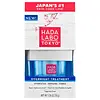What's inside
What's inside
 Key Ingredients
Key Ingredients

 Benefits
Benefits

 Concerns
Concerns

 Ingredients Side-by-side
Ingredients Side-by-side

Water
Skin ConditioningGlycerin
HumectantButyrospermum Parkii Butter
Skin ConditioningIsopropyl Palmitate
EmollientPanthenol
Skin ConditioningCaprylic/Capric Triglyceride
MaskingHydrogenated Coco-Glycerides
EmollientOctyldodecanol
EmollientButylene Glycol
HumectantGlyceryl Stearate Citrate
EmollientStearyl Alcohol
EmollientCetyl Alcohol
EmollientGlycine Soja Germ Extract
EmollientSodium Hyaluronate
HumectantTocopherol
AntioxidantMethyl Methacrylate Crosspolymer
Acrylates/C10-30 Alkyl Acrylate Crosspolymer
Emulsion StabilisingDimethicone
EmollientCarbomer
Emulsion StabilisingCaprylyl Glycol
EmollientTrisodium EDTA
1,2-Hexanediol
Skin ConditioningPhenoxyethanol
PreservativeParfum
MaskingWater, Glycerin, Butyrospermum Parkii Butter, Isopropyl Palmitate, Panthenol, Caprylic/Capric Triglyceride, Hydrogenated Coco-Glycerides, Octyldodecanol, Butylene Glycol, Glyceryl Stearate Citrate, Stearyl Alcohol, Cetyl Alcohol, Glycine Soja Germ Extract, Sodium Hyaluronate, Tocopherol, Methyl Methacrylate Crosspolymer, Acrylates/C10-30 Alkyl Acrylate Crosspolymer, Dimethicone, Carbomer, Caprylyl Glycol, Trisodium EDTA, 1,2-Hexanediol, Phenoxyethanol, Parfum
Water
Skin ConditioningGlycerin
HumectantButylene Glycol
HumectantDimethicone
EmollientPentylene Glycol
Skin ConditioningSqualane
EmollientTrehalose
HumectantTriethylhexanoin
MaskingAmmonium Acryloyldimethyltaurate/Vp Copolymer
Alcohol
AntimicrobialCaprylic/Capric Triglyceride
MaskingChlorphenesin
AntimicrobialDecylene Glycol
Skin ConditioningDimethicone Crosspolymer-3
Skin ConditioningDimethiconol
EmollientDisodium EDTA
Glycine Soja Seed Extract
Skin ConditioningHydrolyzed Collagen
EmollientHydrolyzed Hyaluronic Acid
HumectantHydrolyzed Soy Protein
HumectantKjellmaniella Crassifolia Extract
EmollientLaureth-4
EmulsifyingLaureth-23
CleansingLonicera Japonica Flower Extract
Skin ConditioningPancratium Maritimum Extract
BleachingPEG-8 Methyl Ether Triethoxysilane
Phenoxyethanol
PreservativePhysalis Angulata Extract
Skin ProtectingPullulan
Pvp
Emulsion StabilisingSodium Acetylated Hyaluronate
HumectantSodium Hyaluronate
HumectantTetrapeptide-5
Skin ConditioningTitanium Dioxide
Cosmetic ColorantTocopheryl Acetate
AntioxidantWater, Glycerin, Butylene Glycol, Dimethicone, Pentylene Glycol, Squalane, Trehalose, Triethylhexanoin, Ammonium Acryloyldimethyltaurate/Vp Copolymer, Alcohol, Caprylic/Capric Triglyceride, Chlorphenesin, Decylene Glycol, Dimethicone Crosspolymer-3, Dimethiconol, Disodium EDTA, Glycine Soja Seed Extract, Hydrolyzed Collagen, Hydrolyzed Hyaluronic Acid, Hydrolyzed Soy Protein, Kjellmaniella Crassifolia Extract, Laureth-4, Laureth-23, Lonicera Japonica Flower Extract, Pancratium Maritimum Extract, PEG-8 Methyl Ether Triethoxysilane, Phenoxyethanol, Physalis Angulata Extract, Pullulan, Pvp, Sodium Acetylated Hyaluronate, Sodium Hyaluronate, Tetrapeptide-5, Titanium Dioxide, Tocopheryl Acetate
 Reviews
Reviews

Ingredients Explained
These ingredients are found in both products.
Ingredients higher up in an ingredient list are typically present in a larger amount.
Butylene Glycol (or BG) is used within cosmetic products for a few different reasons:
Overall, Butylene Glycol is a safe and well-rounded ingredient that works well with other ingredients.
Though this ingredient works well with most skin types, some people with sensitive skin may experience a reaction such as allergic rashes, closed comedones, or itchiness.
Learn more about Butylene GlycolThis ingredient is an emollient, solvent, and texture enhancer. It is considered a skin-softener by helping the skin prevent moisture loss.
It helps thicken a product's formula and makes it easier to spread by dissolving clumping compounds.
Caprylic Triglyceride is made by combining glycerin with coconut oil, forming a clear liquid.
While there is an assumption Caprylic Triglyceride can clog pores due to it being derived from coconut oil, there is no research supporting this.
Learn more about Caprylic/Capric TriglycerideDimethicone is a type of synthetic silicone created from natural materials such as quartz.
What it does:
Dimethicone comes in different viscosities:
Depending on the viscosity, dimethicone has different properties.
Ingredients lists don't always show which type is used, so we recommend reaching out to the brand if you have questions about the viscosity.
This ingredient is unlikely to cause irritation because it does not get absorbed into skin. However, people with silicone allergies should be careful about using this ingredient.
Note: Dimethicone may contribute to pilling. This is because it is not oil or water soluble, so pilling may occur when layered with products. When mixed with heavy oils in a formula, the outcome is also quite greasy.
Learn more about DimethiconeGlycerin is already naturally found in your skin. It helps moisturize and protect your skin.
A study from 2016 found glycerin to be more effective as a humectant than AHAs and hyaluronic acid.
As a humectant, it helps the skin stay hydrated by pulling moisture to your skin. The low molecular weight of glycerin allows it to pull moisture into the deeper layers of your skin.
Hydrated skin improves your skin barrier; Your skin barrier helps protect against irritants and bacteria.
Glycerin has also been found to have antimicrobial and antiviral properties. Due to these properties, glycerin is often used in wound and burn treatments.
In cosmetics, glycerin is usually derived from plants such as soybean or palm. However, it can also be sourced from animals, such as tallow or animal fat.
This ingredient is organic, colorless, odorless, and non-toxic.
Glycerin is the name for this ingredient in American English. British English uses Glycerol/Glycerine.
Learn more about GlycerinPhenoxyethanol is a preservative that has germicide, antimicrobial, and aromatic properties. Studies show that phenoxyethanol can prevent microbial growth. By itself, it has a scent that is similar to that of a rose.
It's often used in formulations along with Caprylyl Glycol to preserve the shelf life of products.
Sodium Hyaluronate is hyaluronic acid's salt form. It is commonly derived from the sodium salt of hyaluronic acid.
Like hyaluronic acid, it is great at holding water and acts as a humectant. This makes it a great skin hydrating ingredient.
Sodium Hyaluronate is naturally occurring in our bodies and is mostly found in eye fluid and joints.
These are some other common types of Hyaluronic Acid:
Learn more about Sodium HyaluronateWater. It's the most common cosmetic ingredient of all. You'll usually see it at the top of ingredient lists, meaning that it makes up the largest part of the product.
So why is it so popular? Water most often acts as a solvent - this means that it helps dissolve other ingredients into the formulation.
You'll also recognize water as that liquid we all need to stay alive. If you see this, drink a glass of water. Stay hydrated!
Learn more about Water